#Vue 3.0 Evan
Explore tagged Tumblr posts
Text
Angular Vs. ReactJs Vs. VueJs
The popularity of front-end frameworks is rapidly increasing as they allow developers to build more complex and reliable applications in a minimum time and effort. The web development industry has been transformed by these innovative technologies.
Choosing the right front-end development framework that meets your unique business needs- is a challenging task for every business owner. There are tons of reasons for the pros and cons of each framework, and you'll probably end up back at square one if you try to weigh the pros and cons of each.
Being the oldest front-end framework, Angular is considered the most comprehensive. Or, should you opt for React because React is the most loved framework by many people, and they cannot be wrong at all? Talking about Vue.js, it is younger in the market and going to appear better than the other two.
Well, in this article, we will be talking about the three most popular front-end technologies: Angular, ReactJS, and Vue.js, and we will cover each framework so that you can determine which one best suits your needs.
Let’s get started!
What is Angular?
Angular, developed by Google, was released in 2010 and is a TypeScript-based JavaScript framework. In 2016, Angular 2 (the first release of Angular 2 without the “JS” in its name – AngularJS) represented a shift in positioning and direction from the original AngularJS.
Version 2+ of Angular is just Angular, and although AngularJS (1 version) continues to get updates, we'll talk mainly about Angular, and the most recent version is Angular 13, which was released on November 03, 2021.
There are many top-notch features available with the Angular framework, including control of the user interface, handling user input, validating forms, routing, state management, testing, PWA capabilities, and more. Unlike React, Angular offers a complete collection of framework capabilities.
What is Vue.js?
In 2014, Evan You developed Vue, especially after leaving his job at Google. Although no large company has endorsed Vue, it has seen substantial growth over the past three years.
Contributors for Vue are supported by Patreon, and Vue 3 is currently located in its own GitHub repository; it is run using TypeScript. The current stable version of Vue is 3.0, released in September 2020 (with a few smaller incremental releases since then).
There are more tools in Vue compared to React, but fewer than Angular. It comes with state management and a router but does not offer HTTP client functionality or form validation features.
It makes use of the virtual DOM to ensure faster and bug-free performance. Vue mainly focuses on creating user interfaces and reusable components compared to the other two.
What is React?
Facebook developed React in 2013; React is heavily used by Facebook's products such as Facebook, WhatsApp, and Instagram. The most current stable version is 17.0.2, released in March 2021 and the latest one is also on the headline.
In React, you can create components and subcomponents, which you can think of as UI pieces on a website. One key functionality is building components and subcomponents.
You can also use React to define how your components are rendered and to build SPAs that don't need to refresh the browser, thanks to third-party packages like React Router, a dynamic, non-refreshing routing library.
Overview of Advantages and Limitations
It can be difficult to decide what technology framework to use. The fact is, you cannot pick the best. Each framework has different strengths and weaknesses, so ultimately it depends on your business needs.
There are many factors to consider when choosing a framework, which we will discuss here. However, the most important thing is to choose the framework that you love the most seeing your business's profitability.
Advantages of React JS
A lightweight JS framework with a simple syntax that combines HTML and JavaScript, making it easy to learn. Documentation is readily available, which is a plus for beginners.
Provides excellent support for PWA (progressive web app) especially when you create-react-app templates.
It offers Virtual DOM implementation and rendering optimizations which makes it extremely fast.
Using functional programming with components, react creates modularized code that can be reused, resulting in easier maintenance and scaling. Apps can be developed more easily and scaled with more scalable infrastructure.
Limitations
There have been constant changes in React technology, which makes it a bit challenging to keep up with the latest documentation.
Developers can make design choices freely since React technology is unopinionated.
React utilizes JSX, which creates a learning barrier for some developers, despite its benefits.
Advantages of Angular
Angular makes use of TypeScript, which provides great support for type checking and other external tooling.
Google provides support for Angular, so it can be said that it is a trustworthy framework.
They offer detailed documentation with a huge community, which makes it easier to learn.
Autocomplete is supported inside external HTML templates for components in Angular, allowing for faster development times.
Limitations
There is a slowdown in performance due to the real DOM used, but this can be remedied with the use of ChangeDetectionStrategy, which assists in writing manual code.
Angular offers a comprehensive range of structures including various modules, components, pipes, etc., which makes it hard to learn this framework compared to React and Vue, which mainly rely on the components.
Advantages of Vue.js
Vue comes with detailed documentation, which helps developers overcome their learning curve. With just a basic knowledge of HTML and JavaScript, developers can construct powerful single-page applications.
Vue is used to design robust single-page web applications.
Vue has a smaller footprint, so its speed and flexibility are optimal, which gives better performance compared to other frameworks.
It can be integrated easily with existing infrastructure without having any impact on the system.
Vue uses virtual DOM, which makes it faster than Angular.
Limitations
As a relatively new technology with a tiny market share, Vue has fewer resources than React and Angular, meaning that support and knowledge sharing are less common.
How to Choose the Right Javascript Framework for your Project?
It remains to be answered - when are the three frameworks to be chosen? Which benefits should be exploited to the maximum? We have listed the following criteria that can help you make the right decision regarding the most appropriate platform for your project based on the major advantages and disadvantages of each framework:
Choose Angular:
When you want to create a large and complex project such as building enterprise applications with Angular
When you are looking for simplicity
When you want great reliability and scalability
When you have Angular developers on your team
When you can afford some time to learn TypeScript before the project starts
Choose React:
When your project can accept reusable components
When your project’s front end is not too complex
When your performance and scalability are important
When you are having tight deadlines
When you are looking for relevant experience in React.js development.
Choose Vue.js:
When your project scope is on the small side
When you want superior performance
When you have experienced front-end developers but have team members with JavaScript knowledge
When you are not experienced in learning a new technology
Angular, React, and Vue.js are by no means the only front-end frameworks available. There are a lot of exciting tools that will suit projects of different sizes and complexity.
It shouldn't be hard to put together the right technology stack and deliver a great software solution with the right approach and common sense.
JavaScript-based tools are available along with front-end development frameworks. You can always count on us for any development team you need to hire, such as a React.js developer team for example.
Let’s make a detailed comparison between Angular Vs. ReactJs Vs VueJs one by one:
Angular Vs. ReactJs Vs VueJs: Framework Size
Size matters for development frameworks since size influences application performance. Angular is one of the heaviest in size, with 143k. A framework and its application must be downloaded before an application can be used.
The second most popular framework is React, with a size of 43k, and the lightest framework is Vue.js, with only 23k. Therefore, if your application is not more complex and doesn’t have many sophisticated components, choosing the smaller framework would be the best option.
Angular Vs. ReactJs Vs VueJs: Performance
It is important to know that Web application performance directly depends on the Document Object Model, or DOM, which represents a web page in both the browser and in the source code. The DOM is what allows web pages to be modified during an update process.
When only one item is changed on a web page, Angular updates the entire page and re-renders the whole web page. Regular DOM, particularly in single-page applications, affects performance, making it its Achilles' heel.
As both React and Vue.js make use of virtual DOM, they leave Angular in the dust. Changes can be made in a copy of the DOM without affecting the actual DOM. In addition, just the modified components of the virtual DOM are rerendered, and the updated virtual DOM is compared to a snapshot of the regular DOM. The performance of the application is greatly improved by this approach.
Angular Vs. ReactJs Vs VueJs: Community
React was rated the most popular framework for developers in the 2017 Stack Overflow Developer Survey. The app enjoyed unparalleled popularity and support because it was constructed by the Facebook team. With more than thirty thousand developer members now contributing to React's development, its developer community has now exceeded thirty thousand members.
Traditional users have appreciated the advantages of Angular and the community has been quite supportive. Even with the statistics by Bestof.js showing AngularJS still has a lot more followers than its later versions, the first version of Angular still has many more followers.
Although Vue.js has many advantages, it doesn't appear to be popular with developers despite its advantages. Collaboration on framework functionality improves the framework's functionality and, more importantly, its library collection expands.
The components in React are sure to be reusable since they have been contributed by peers. In other words, React might be your best option if you are looking for community support and ready-made components.
Angular Vs. ReactJs Vs VueJs: Popularity
Google Trends provides little insight into the popularity of "angular" and "react" since they are frequently used terms. However, the number of stars they receive on their GitHub repo is a good barometer of their popularity.
Recently, Vue has been up there with React among the top frameworks. After a sudden drop in stars in mid-2016, it is back on top. Your development team will be able to overcome the shortcomings of these frameworks, regardless of which business framework you use.
If the team is in the right hands, it can be assured that this will happen. Moreover, your developers are experts and understand these frameworks inside and out, so you can always rely on them to deliver the solutions you need.
Or you can hire dedicated developers who are proficient in Vue.js, React, and Angular from a reputable company.
Angular Vs. ReactJs Vs VueJs: Scalability
The ability to maintain an expanding functionality is the essence of scalability as it applies to front-end development. A development platform should be able to support the growth of applications as they grow in size and complexity.
Both Angular and React are easily scalable when it comes to building scalable applications, according to developers almost unanimously. Modular development with Angular provides scalability, while component-based development with React yields excellent results.
Because it uses template-based syntax, Vue.js has a disastrous record when it comes to scalability. It becomes increasingly difficult to reuse templates within a large application, compared with JavaScript components.
Angular Vs. ReactJs Vs VueJs: Learning Curve
It is very subjective that for some people technology A may be easier to learn than technology B; while others may find it difficult to learn. Having mastered JavaScript and understanding its concepts is the first step to learning the front end, so all three should be equally easy for you.
Because Typescript is good to know when writing Angular apps (despite it not being required), it may cause more problems with Angular. React.js and VueJS appear to be more accessible to beginners than other frameworks, according to my research. However, individual preferences play a large role here.
Angular Vs. ReactJs Vs VueJs: User Friendliness
Angular, React, and Vue.js are the three most difficult technologies in that order. As a result, Vue.js has an advantage. It is easy for organizations to hire and onboard experienced JS developers, and also want to make them work seamlessly with Vue.js.
Angular Vs. ReactJs Vs VueJs: Popular Projects
Now we would like to sum up this article with this final point, describing some well-known projects that have utilized each of these frameworks, illustrating that you can accomplish big things no matter what the technology is.
Netflix, Facebook, and Instagram are some of the most popular websites using Angular. React.js powers more popular websites including Forbes, BMW Price calculator, Santander Bank, etc. Some of the leading names like Alibaba, 9GAG, and FontAwesome are powered by Vue.js.
Final thoughts
The major components of these frameworks are under continuous development, and new versions are released regularly as well as maintenance of existing ones. Since all of these frameworks have a high level of support, you can use them all safely. In contrast, Vue - which started more recently but is still growing quickly - is not growing as fast as Angular.
It is impossible to say which frameworks will be relevant in the long run, but each project is backed by a great community, and each is continually evolving. It's important to take a few things into account before jumping into a new framework. First, the expertise of your team can play a big role in choosing a new technology.
Hiring dedicated developers for your project from a leading custom web development company can also help. Lastly, your choice of framework may also be affected by the complexity and scope of the project itself. You can use this information to decide which front-end framework is best for your needs and goals by taking into account all the key differences.
0 notes
Photo
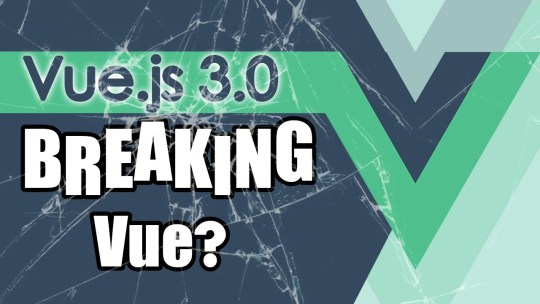
Is Vue.js 3.0 Breaking Vue? Vue 3.0 Preview! Vue 3.0 is in RFC mode right now. But what does it change? In this video I discuss the changes in Vue 3.0 and you can see what breaking changes there is! source
#Breaking#Erik Hanchett#evan you#Evan you Vue.js#Preview#Program With Eric#Program With Erik#vue#Vue 2019#Vue 3#Vue 3 breaking changes#Vue 3 preview#Vue 3 Preview 2019#Vue 3 RFC#Vue 3 Setup#Vue 3 vs Vue 2#Vue 3.0 Evan#Vue 3.0 typescript#vue js#vue js 2019#Vue.js 3 tutorial#Vue.js 3.0#Vue.js 3.0 RFC#vuejs#What is the changes in Vue 3
0 notes
Photo

Vue 3.0 Updates with Evan You ☞ https://school.geekwall.in/p/rJAXV0r_S/vue-3-0-updates-with-evan-you #vuejs #javascript
3 notes
·
View notes
Photo

Evan You Previews Vue.js 3.0 🔥 ☞ https://school.geekwall.in/p/B1c440r_S/evan-you-previews-vue-js-3-0 #vuejs #javascript
1 note
·
View note
Photo

Vue 3.0 Updates with Evan You ☞ https://school.geekwall.in/p/rJAXV0r_S/vue-3-0-updates-with-evan-you #vuejs #javascript
1 note
·
View note
Photo

Vue 3.0 Updates with Evan You ☞ https://school.geekwall.in/p/rJAXV0r_S/vue-3-0-updates-with-evan-you #vuejs #javascript
3 notes
·
View notes
Photo

Vue 3.0 Updates with Evan You ☞ https://school.geekwall.in/p/rJAXV0r_S/vue-3-0-updates-with-evan-you #vuejs #javascript
3 notes
·
View notes
Text
What is Vue JS?
Vue (articulated/vju/, like view) is an ever-evolving system for building UIs. In contrast to other solid systems, Vue is planned to start from the earliest stage to be steadily adoptable. The center library is centered around the view layer just and is not difficult to get and coordinate with different libraries or existing activities. Then again, Vue is likewise entirely equipped for controlling refined Single-Page Applications when utilized in mix with current tooling and supporting libraries.
What is VUE JS used for?
VueJS is basically used to fabricate web interfaces and one-page applications. In saying that, it can likewise be applied to both work area and portable application improvement because of the HTML augmentations and JS base working couple with an Electron system making it a vigorously preferred frontend instrument.
Competition
Each structure has its own elements and qualities, in view of which they are known and get needed over some other system. Vue.js has a record of having the most stars at Github.com for the beyond 5 years. Albeit the local area of Vue.js is more modest than the respond JS, Vue.js stars record is portraying and telling with regards to the devotees of Vue.js. Whoever utilizes it once, he/goes gaga for it.
Development and Growth
Vue was delivered way back in 2014. From that point forward, it is persistently developing. Toward the start of 2018, Vue.js began beating Angular and turning out to be more renowned on the lookout. Afterward, in September 2018, Evan You chose to declare the arrival of Vue 3.0. Vue.js is consistently developing with the fast development in the utilization and local area of this system. The people group will continue to develop in light of the fact that it was based on the best highlights mix of Angular and React.
Here is a portion of the highlights that we observe invigorating and the underlying driver of its fast development and make it cool.
Modular and reusable code
This part-based methodology was essentially motivated by and picked from ReactJS. We compose code as parts to import that part and reuse it any place we want it. Vue.js offers a solitary document part, which makes it an inexactly coupled and reusable code.
Learning Curve & Well written Documentation
Vue.js has one of the most mind-blowing composed Documentation that we have at any point seen and recommended. This Documentation takes us through an easy and bit-by-bit guide that one doesn’t feel like hard learning or something other than what's expected is going on. The expectation to absorb information is easy on the off chance that we contrast it and the react.JS andAngular.
0 notes
Link
In 2020, we are blessed with a number of frameworks and libraries to help us with web development. But there wasn't always so much variety. Back in 2005, a new scripting language called Mocha was created by a guy named Brendan Eich. Months after being renamed to LiveScript, the name was changed again to JavaScript. Since then, JavaScript has come a long way.
In 2010, we saw the introduction of Backbone and Angular as the first JavaScript frameworks and, by 2016, 92 per cent of all websites used JavaScript. In this article, we are going to have a look at three of the main JavaScript frameworks (Angular, React and Vue) and their status heading into the next decade.
For some brilliant resources, check out our list of top web design tools, and this list of excellent user testing software, too.
01. Angular
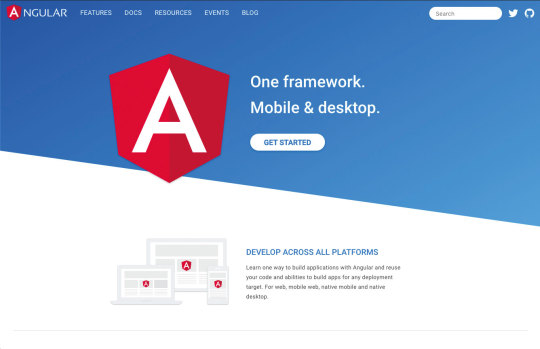
AngularJS was released in 2010 but by 2016 it was completely rewritten and released as Angular 2. Angular is a full- blown web framework developed by Google, which is used by Wix, Upwork, The Guardian, HBO and more.
Pros:
Exceptional support for TypeScript
MVVM enables developers to separate work on the same app section using the same set of data
Excellent documentation
Cons:
Has a bit of a learning curve
Migrating from an old version can be difficult.
Updates are introduced quite regularly meaning developers need to adapt to them
What's next?
In Angular 9, Ivy is the default compiler. It's been put in place to solve a lot of the issues around performance and file size. It should make applications smaller, faster and simpler.
When you compare previous versions of Angular to React and Vue, the final bundle sizes were a lot a bigger when using Angular. Ivy also makes Progressive Hydration possible, which is something the Angular team showed off at I/O 2019. Progressive Hydration uses Ivy to load progressively on the server and the client. For example, once a user begins to interact with a page, components' code along with any runtime is fetched piece by piece.
Ivy seems like the big focus going forward for Angular and the hope is to make it available for all apps. There will be an opt-out option in version 9, all the way through to Angular 10.
02. React

React was initially released in 2013 by Facebook and is used for building interactive web interfaces. It is used by Netflix, Dropbox, PayPal and Uber to name a few.
Pros:
React uses the virtual DOM, which has a positive impact on performance
JSX is easy to write
Updates don't compromise stability
Cons:
One of the main setbacks is needing third-party libraries to create more complex apps
Developers are left in the dark on the best way to develop
What's next?
At React Conf 2019, the React team touched on a number of things they have been working on. The first is Selective Hydration, which is where React will pause whatever it's working on in order to prioritise the components that the user is interacting with. As the user goes to interact with a particular section, that area will be hydrated. The team has also been working on Suspense, which is React's system for orchestrating the loading of code, data and images. This enables components to wait for something before they render.
Both Selective Hydration and Suspense are made possible by Concurrent Mode, which enables apps to be more responsive by giving React the ability to enter large blocks of lower priority work in order to focus on something that's a higher priority, like responding to user input. The team also mentioned accessibility as another area they have been looking at, by focusing on two particular topics – managing focus and input interfaces.
03. Vue
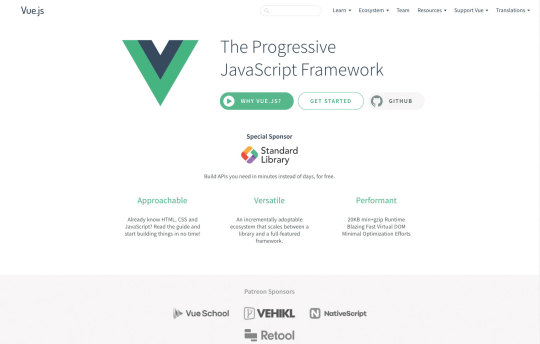
Vue was developed in 2014 by Evan You, an ex-Google employee. It is used by Xiaomi, Alibaba and GitLab. Vue managed to gain popularity and support from developers in a short space of time and without the backing of a major brand.
Pros:
Very light in size
Beginner friendly – easy to learn
Great community
Cons:
Not backed by a huge company, like React with Facebook and Angular with Google
No real structure
What's next?
Vue has set itself the target of being faster, smaller, more maintainable and making it easier for developers to target native. The next release (3.0) is due in Q1 2020, which includes a virtual DOM rewrite for better performance along with improved TypeScript Support. There is also the addition of the Composition API, which provides developers with a new way to create components and organise them by feature instead of operation.
Those developing Vue have also been busy working on Suspense, which suspends your component rendering and renders a fallback component until a condition is met.
One of the great things with Vue's updates is they sustain backward compatibility. They don't want you to break your old Vue projects. We saw this in the migration from 1.0 to 2.0 where 90 per cent of the API was the same.
How does the syntax of frameworks compare?
All three frameworks have undergone changes since their releases but one thing that's critical to understand is the syntax and how it differs. Let's have a look at how the syntax compares when it comes to simple event binding:
Vue: The v-on directive is used to attach event listeners that invoke methods on Vue instances. Directives are prefixed with v- in order to indicate that they are special attributes provided by Vue and apply special reactive behaviour to the rendered DOM. Event handlers can be provided either inline or as the name of the method.
React: React puts mark up and logic in JS and JSX, a syntax extension to JavaScript. With JSX, the function is passed as the event handler. Handling events with React elements is very similar to handling events on DOM elements. But there are some syntactic differences; for instance, React events are named using camelCase rather than lowercase.
Angular: Event binding syntax consists of a target event name within parentheses on the left of an equal sign and a quoted template statement on the right. Alternatively, you can use the on- prefix, known as the canonical form.
Popularity and market
Let's begin by looking at an overall picture of the three frameworks in regards to the rest of the web by examining stats from W3Techs. Angular is currently used by 0.4 per cent of all websites, with a JavaScript library market share of 0.5 per cent. React is used by 0.3 per cent of all websites and a 0.4 per cent JavaScript library market share and Vue has 0.3 per cent for both. This seems quite even and you would expect to see the numbers rise.
Google trends: Over the past 12 months, React is the most popular in search terms, closely followed by Angular. Vue.js is quite a way behind; however, one thing to remember is that Vue is still young compared to the other two.
Job searches: At the time of writing, React and Angular are quite closely matched in terms of job listings on Indeed with Vue a long way behind. On LinkedIn, however, there seems to be more demand for Vue developers.
Stack Overflow: If you look at the Stack Overflow Developer Survey results for 2019, React and Vue.js are both the most loved and wanted web frameworks. Angular sits down in ninth position for most loved but third most wanted.
GitHub: Vue has the most number of stars with 153k but it has the least number of contributors (283). React on the other hand has 140k stars and 1,341 contributors. Angular only has 59.6k stars but has the highest number of contributors out of the three with 1,579.
NPM Trends: The image above shows stats for the past 12 months, where you can see React has a higher number of downloads per month compared to Angular and Vue.
Mobile app development
One main focus for the big three is mobile deployment. React has React Native, which has become a popular choice for building iOS and Android apps not just for React users but also for the wider app development community. Angular developers can use NativeScript for native apps or Ionic for hybrid mobile apps, whereas Vue developers have a choice of NativeScript or Vue Native. Because of the popularity of mobile applications, this remains a key area of investment.
Other frameworks to look out for in 2020
If you want to try something new in 2020, check out these JavaScript frameworks.
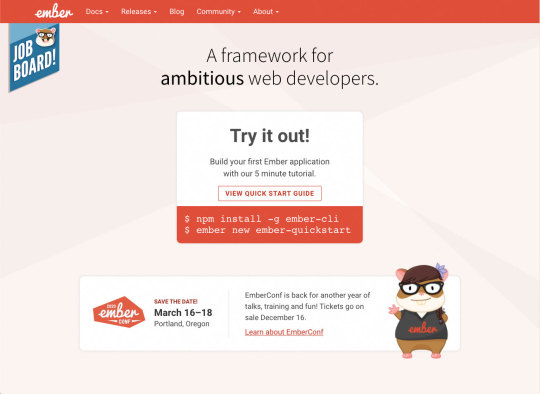
Ember: An open-source framework for building web applications that works based on the MVVM pattern. It is used by several big companies like Microsoft, Netflix and LinkedIn.
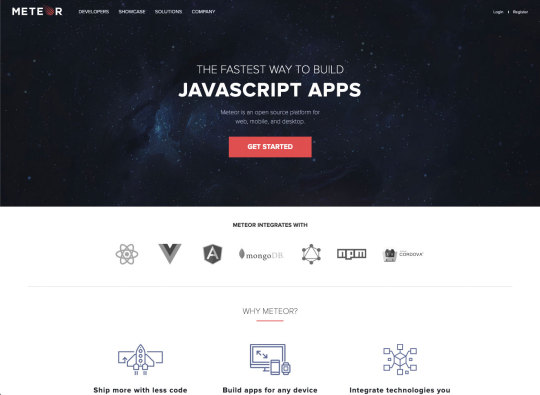
Meteor: A full-stack JavaScript platform for developing modern web and mobile applications. It's easy to learn and has a very supportive community.
Conclusion
All three frameworks are continually improving, which is an encouraging sign. Everyone has their own perspective and preferred solution about which one they should use but it really comes down to the size of the project and which makes you feel more comfortable.
The most important aspect is the continued support of their communities, so if you are planning to start a new project and have never used any of the three before, then I believe you are in safe hands with all of them. If you haven't had a chance to learn any of the three frameworks yet, then I suggest making it your New Year's resolution to start learning. The future will revolve around these three.
0 notes
Photo

Vue 3.0 Updates with Evan You ☞ https://school.geekwall.in/p/rJAXV0r_S/vue-3-0-updates-with-evan-you #vuejs #javascript
0 notes
Photo

Vue 3.0 Updates with Evan You ☞ https://school.geekwall.in/p/rJAXV0r_S/vue-3-0-updates-with-evan-you #vuejs #javascript
0 notes
Photo

Vue 3.0 Updates with Evan You ☞ https://school.geekwall.in/p/rJAXV0r_S/vue-3-0-updates-with-evan-you #vuejs #javascript
0 notes
Photo

Vue 3.0 Updates with Evan You ☞ https://school.geekwall.in/p/rJAXV0r_S/vue-3-0-updates-with-evan-you #vuejs #javascript
0 notes
Photo

Vue 3.0 Updates with Evan You ☞ https://school.geekwall.in/p/rJAXV0r_S/vue-3-0-updates-with-evan-you #vuejs #javascript
0 notes
Photo

Evan You Previews Vue.js 3.0 🔥 ☞ https://school.geekwall.in/p/B1c440r_S/evan-you-previews-vue-js-3-0 #vuejs #javascript
0 notes
Photo

The Design Principles of Vue 3.0: https://t.co/LrIxEoDpWX (A 50 minute talk from the creator of Vue.js, Evan You, on the principles behind the changes coming in Vue 3.0.) #video
0 notes